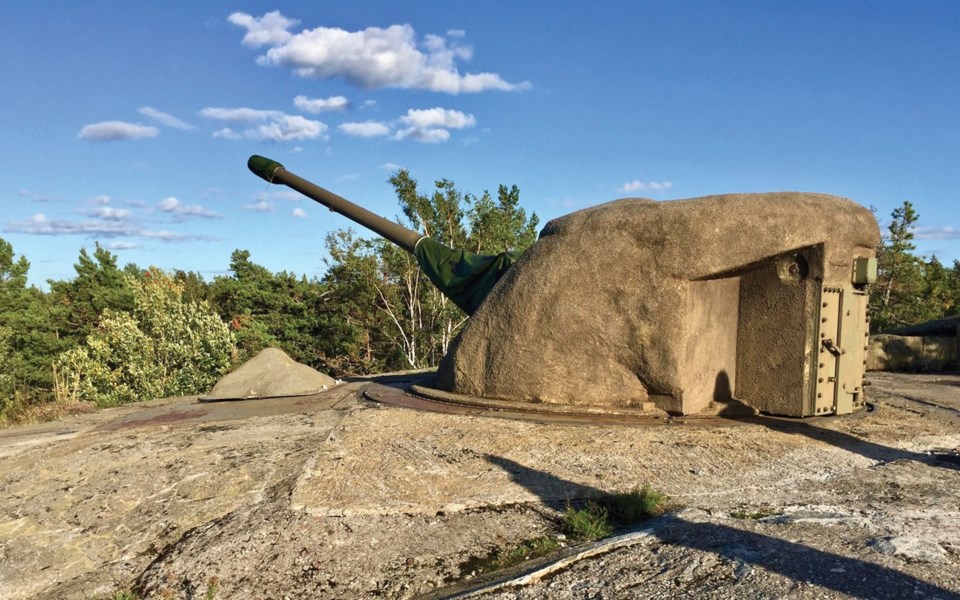Remember the Cold War? It's a generational thing, and since Whistler is full of people born in the 1990s, you're forgiven if you know little of this period of nuclear posturing, space-racing, and proxy cabals—the Warsaw Pact and NATO, respectively—between the former Soviet Union and United States. This finger-on-the-button standoff, embodied in the MAD (Mutual Assured Destruction) Doctrine, had the world on missile pins and warhead needles for some 40 years.
When tensions dissipated in 1989 after the fall of the physical/philosophical barrier known as the Berlin Wall, it was also curtains for myriad other Cold War infrastructure erected at strategic -waypoints between the two superpowers. Of these, Canadians are most familiar with the DEW (Distant Early Warning) Line—radar installations strung across the high Arctic and North Atlantic to track incoming Soviet bombers and missiles. But there was much more, including a range of defense initiatives in countries adjacent to the two military behemoths (i.e. the thwarted Soviet attempt to set up a missile base in Cuba).
Of particular interest, should hostilities have broken out, was the Baltic Sea, ringed on one side by Russia, the Soviet Baltic States, and their Warsaw-pact buddy Poland, and on the other by NATO countries Denmark, Norway, and ever-powerful Germany. Between these ideologically-opposed terroirs stood what could become de facto battlegrounds—the "officially" neutral countries of Finland and Sweden.
During the Second World War, Finland ejected the Soviets on two separate occasions, while Norway rebuffed the Germans. Sweden, however, was never occupied by any foreign force—one reason for its exceptional post-war prosperity, backed by the American Marshall Plan. The country's Cold War posture was thus characterized by ostensible political neutrality—despite the fact that this would have been impossible in the event of actual war. In that case, Sweden's only hope would be nuclear support from the U.S.; thus, its military ties with NATO were top-secret.
With half the border between Western Europe and the Soviet Union represented by the Baltic, many confrontations occurred here, including the Soviet downing of a Swedish aircraft in 1952, and a Soviet submarine that ran aground in 1981 near a Swedish naval base, sparking a political crisis between the nations. In reality, Sweden's labyrinthine 1,500-kilometre Baltic coast concealed the world's most powerful seaward defense system, with strategically located artillery (about 90 heavy cannons with many underground facilities), submarines, battleships, and, at one time, the world's fourth largest air force.
This was obviously expensive to maintain, so when the Cold War fizzled, Sweden wasted little time mothballing many of its prodigious defenses. Some were sensitive enough that they needed to either be fully dismantled or filled with concrete—also costly. But the ever-practical Swedes hit on a solution. They could decommission all bases for $50 million each or spend $5 million turning some into tourist attractions that returned the investment with paid admissions. Which brings us to Arholma Battery, the country's most secretive defense placement in one of its most hallowed idylls—the northernmost edge of the Stockholm archipelago.
On the island of Arholma, between the late '50s and 1968, engineers blasted a four-level underground facility into pure granite and equipped it with the most advanced artillery of the day—a fully automatic 10.5-centimetre fixed cannon that could uncork 35 shells a minute with a range of 20 kilometres and accuracy of half a metre.
A crew of 110 served in the caverns of Arholma, completely unknown to the enemy or even Swedes enjoying their summers in the archipelago. Shuttered in 1992 but kept under wraps pending disposition, Arholma was eventually opened to the public as a real-life(ish) museum in 2008, its gun playfully pointed toward Russia.
Now, twice-daily guided tours shuffle through in summer. Most arrive by boat from surrounding islands, but some are already onsite, as the clever Swedes have also created a remote island destination—Arholma Nord, featuring high-end cabins, a youth hostel, seaside sauna, restaurant, and activities like hiking, zip-lining, mountain biking, kayaking, and SUPing. Which is how I unknowingly came across this dusty corner of Cold War history.
Arriving in late September to experience Arholma Nord on the heels of the summer crowds, our party was invited to make the last battery tour of the season. Not even knowing it was there we had no idea what we were in for.
A camouflaged razor-wire entrance led through a heavy iron doorway into a clammy, bunker-esque warren built to withstand a nuclear attack. The men had slept in dank, crowded, submarine-like bunks in a complex that otherwise featured freshwater and air-circulation generators, machine and electrical shops, rooms full of computer and radar screens, a field hospital, kitchen and dining area—even a library with the original gun blueprints.
Imagine the lair of Dr. Evil and you get the picture—made even more campy by creepy '70s-era mannequins fitted in Swedish military uniforms and other clothing of the time.
The emergency this was all built for never happened, but the stark reality of readiness remained embodied in a lever on a blue alarm box in the room where the metre-long shells for the gun were loaded into cassettes. There were only two positions the lever could be set in, krig or fred—war or peace.
Leslie Anthony is a Whistler-based author, editor, biologist and bon vivant who has never met a mountain he didn't like.




